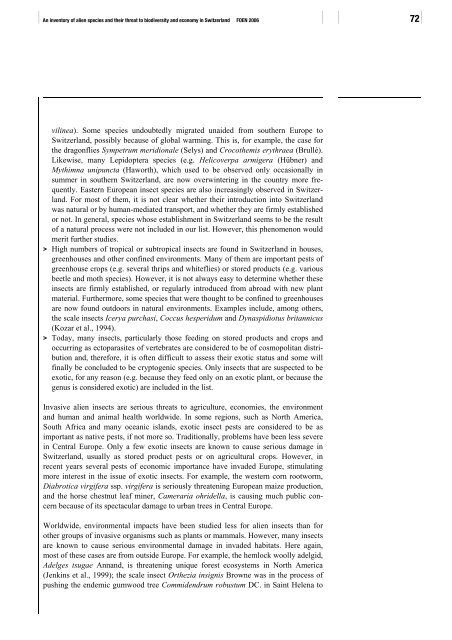Invasive alien species in Switzerland - Schweizer ...
Invasive alien species in Switzerland - Schweizer ...
Invasive alien species in Switzerland - Schweizer ...
You also want an ePaper? Increase the reach of your titles
YUMPU automatically turns print PDFs into web optimized ePapers that Google loves.
An <strong>in</strong>ventory of <strong>alien</strong> <strong>species</strong> and their threat to biodiversity and economy <strong>in</strong> <strong>Switzerland</strong> FOEN 2006 72<br />
vil<strong>in</strong>ea). Some <strong>species</strong> undoubtedly migrated unaided from southern Europe to<br />
<strong>Switzerland</strong>, possibly because of global warm<strong>in</strong>g. This is, for example, the case for<br />
the dragonflies Sympetrum meridionale (Selys) and Crocothemis erythraea (Brullé).<br />
Likewise, many Lepidoptera <strong>species</strong> (e.g. Helicoverpa armigera (Hübner) and<br />
Mythimna unipuncta (Haworth), which used to be observed only occasionally <strong>in</strong><br />
summer <strong>in</strong> southern <strong>Switzerland</strong>, are now overw<strong>in</strong>ter<strong>in</strong>g <strong>in</strong> the country more frequently.<br />
Eastern European <strong>in</strong>sect <strong>species</strong> are also <strong>in</strong>creas<strong>in</strong>gly observed <strong>in</strong> <strong>Switzerland</strong>.<br />
For most of them, it is not clear whether their <strong>in</strong>troduction <strong>in</strong>to <strong>Switzerland</strong><br />
was natural or by human-mediated transport, and whether they are firmly established<br />
or not. In general, <strong>species</strong> whose establishment <strong>in</strong> <strong>Switzerland</strong> seems to be the result<br />
of a natural process were not <strong>in</strong>cluded <strong>in</strong> our list. However, this phenomenon would<br />
merit further studies.<br />
> High numbers of tropical or subtropical <strong>in</strong>sects are found <strong>in</strong> <strong>Switzerland</strong> <strong>in</strong> houses,<br />
greenhouses and other conf<strong>in</strong>ed environments. Many of them are important pests of<br />
greenhouse crops (e.g. several thrips and whiteflies) or stored products (e.g. various<br />
beetle and moth <strong>species</strong>). However, it is not always easy to determ<strong>in</strong>e whether these<br />
<strong>in</strong>sects are firmly established, or regularly <strong>in</strong>troduced from abroad with new plant<br />
material. Furthermore, some <strong>species</strong> that were thought to be conf<strong>in</strong>ed to greenhouses<br />
are now found outdoors <strong>in</strong> natural environments. Examples <strong>in</strong>clude, among others,<br />
the scale <strong>in</strong>sects Icerya purchasi, Coccus hesperidum and Dynaspidiotus britannicus<br />
(Kozar et al., 1994).<br />
> Today, many <strong>in</strong>sects, particularly those feed<strong>in</strong>g on stored products and crops and<br />
occurr<strong>in</strong>g as ectoparasites of vertebrates are considered to be of cosmopolitan distribution<br />
and, therefore, it is often difficult to assess their exotic status and some will<br />
f<strong>in</strong>ally be concluded to be cryptogenic <strong>species</strong>. Only <strong>in</strong>sects that are suspected to be<br />
exotic, for any reason (e.g. because they feed only on an exotic plant, or because the<br />
genus is considered exotic) are <strong>in</strong>cluded <strong>in</strong> the list.<br />
<strong>Invasive</strong> <strong>alien</strong> <strong>in</strong>sects are serious threats to agriculture, economies, the environment<br />
and human and animal health worldwide. In some regions, such as North America,<br />
South Africa and many oceanic islands, exotic <strong>in</strong>sect pests are considered to be as<br />
important as native pests, if not more so. Traditionally, problems have been less severe<br />
<strong>in</strong> Central Europe. Only a few exotic <strong>in</strong>sects are known to cause serious damage <strong>in</strong><br />
<strong>Switzerland</strong>, usually as stored product pests or on agricultural crops. However, <strong>in</strong><br />
recent years several pests of economic importance have <strong>in</strong>vaded Europe, stimulat<strong>in</strong>g<br />
more <strong>in</strong>terest <strong>in</strong> the issue of exotic <strong>in</strong>sects. For example, the western corn rootworm,<br />
Diabrotica virgifera ssp. virgifera is seriously threaten<strong>in</strong>g European maize production,<br />
and the horse chestnut leaf m<strong>in</strong>er, Cameraria ohridella, is caus<strong>in</strong>g much public concern<br />
because of its spectacular damage to urban trees <strong>in</strong> Central Europe.<br />
Worldwide, environmental impacts have been studied less for <strong>alien</strong> <strong>in</strong>sects than for<br />
other groups of <strong>in</strong>vasive organisms such as plants or mammals. However, many <strong>in</strong>sects<br />
are known to cause serious environmental damage <strong>in</strong> <strong>in</strong>vaded habitats. Here aga<strong>in</strong>,<br />
most of these cases are from outside Europe. For example, the hemlock woolly adelgid,<br />
Adelges tsugae Annand, is threaten<strong>in</strong>g unique forest ecosystems <strong>in</strong> North America<br />
(Jenk<strong>in</strong>s et al., 1999); the scale <strong>in</strong>sect Orthezia <strong>in</strong>signis Browne was <strong>in</strong> the process of<br />
push<strong>in</strong>g the endemic gumwood tree Commidendrum robustum DC. <strong>in</strong> Sa<strong>in</strong>t Helena to
















